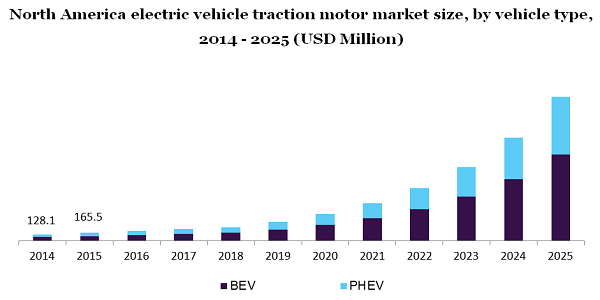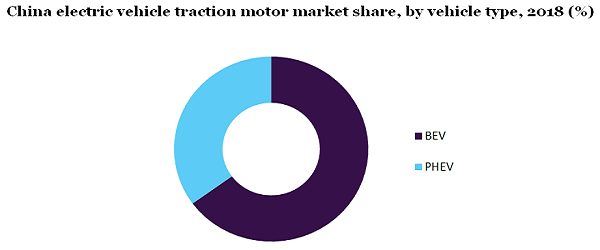- US: +1-408-610-2300
- Toll Free: +1-866-831-4085
- Become a Client
The electric vehicle traction motor market size across the globe was valued at USD 1.98 billion in 2018. It is projected to witness a 41.6% CAGR over the forecasted years, 2019 to 2025. The rising investments for the development of electric vehicles (EVs) coupled with the surging need for energy-efficient motors are projected to drive the market growth. Moreover, features like higher operational efficiency and less power consumption are anticipated to propel their demand in the upcoming years.
Several regulatory norms are being imposed by governing authorities for reducing air pollution caused due to emission of harmful gases from vehicles. They also help in safeguarding environmental sustainability, thereby acting as a major driver for the demand for electric vehicles and their parts. Also, the initiatives undertaken by governments like discounts and tax subsidies for promoting sales of EVs are projected to propel market growth.

These traction motors are majorly used in BEVs (Battery Electric Vehicles) and HEVs (Hybrid electric vehicles) owing to their features like higher fuel efficiency and zero emissions. Also, benefits like faster acceleration and quieter operations than traditional motors are projected to boost the demand for traction motors.
However, issues caused due to overheating of these traction motors are projected to hinder their market growth. Further, electric and magnetic losses during operations coupled with the need for skilled engineers for installation are expected to obstruct the aftersales demand. Therefore, several manufacturers have started investing in R&D activities which are anticipated to propel the market growth over the forecasted period.
The global EV traction motor market can be segmented into BEV and PHEV based on vehicle type. In 2018, the BEV accounted for the largest share across the global market. It is also projected to register the highest CAGR from 2019 to 2025. This can be associated with their rising demand owing to the usage of electric motors and motor controllers rather than the traditional IC engines.

Rapid technological advances like high-powered batteries along with fast charging features are projected to drive the demand for the BEV segment. The key players are engaged in developing batteries with higher capacities or around 60kWh for increasing their range to 200 miles with a single charge. This enhanced capacity of the electric vehicle's battery is projected to drive the demand for traction motors across the globe.
The Asia Pacific accounted for the largest share across the global market in 2018. It is also projected to register the fastest growth in the upcoming years. This growth can be attributed to the increasing presence of several manufacturing facilities across this region. China holds many large-scale manufacturing facilities owing to the availability of labor at lower costs and ease of availability of raw materials.
North America also accounted for a significant share across the global market in 2018 and is projected to register a 35.0% CAGR from 2019 to 2025. This can be associated with the rising presence of electric vehicle producers across countries like the U.S. and Canada. In 2018, Europe accounted for a share of more than 20.0% across the market owing to the rising demand for BEVs across this region.
The market growth has been hindered on account of the ongoing COVID-19 pandemic. A majority of the suppliers and raw material manufacturers of traction motors are located across China; their global supply chain has been obstructed due to restrictions over cargo movements by several countries. Moreover, the imposition of lockdown and stagnancy in the production of EVs due to the reduction in the availability of skilled laborers is projected to hamper the demand for EV traction motors. Also, the tendency over repair and maintenance instead of replacement due to reduced income in the pandemic period has impacted the aftersales service of traction motors. These factors are also expected to retard the market growth over the post-pandemic period.
The global market includes key players such as ABB Limited, SKF AB, Parker-Hannifin Corp., Nidec Corporation, YASA Motors Ltd., Hitachi Ltd., and Robert Bosch GMBH. These players are developing long-term strategic alliances and agreements with OEMs and other manufacturers for reducing costs and risks associated with the demand for traction motors.
These players are investing in R&D activities for developing motors with lightweight and higher efficiency. Several strategies such as partnerships and acquisitions are being undertaken by these players for widening their product portfolio and geographical reach. For example, Nidec Corporation signed a partnership with the PSA Group in 2018 for producing and designing traction motors across France.
|
Attribute |
Details |
|
The base year for estimation |
2018 |
|
Actual estimates/Historical data |
2014 - 2017 |
|
Forecast period |
2019 - 2025 |
|
Market representation |
Revenue in USD billion and CAGR from 2019 to 2025 |
|
Regional Scope |
North America; Europe; Asia Pacific; Latin America; MEA |
|
Country Scope |
U.S., Canada, U.K., Germany, France, Norway, Netherlands, Sweden, China, India, Japan, Korea, Brazil, Mexico |
|
Report coverage |
Revenue forecast, competitive landscape, growth factors, and trends |
|
15% free customization scope (equivalent to 5 analyst working days) |
If you need specific information, which is not currently within the scope of the report, we will provide it to you as a part of the customization |
This report forecasts revenue growth at the global, regional, and country levels and provides an analysis of the latest industry trends from 2014 to 2025 in each of the sub-segments. For the purpose of this study, Million Insights has segmented the global electric vehicle traction motor market on the basis of vehicle type and region:
• Vehicle Type Outlook (Revenue, USD Million, 2014 - 2025)
• BEV
• PHEV
• Regional Outlook (Revenue, USD Million, 2014 - 2025)
• North America
• The U.S.
• Canada
• Europe
• The U.K.
• Germany
• France
• Norway
• Netherlands
• Sweden
• The Asia Pacific
• China
• India
• Japan
• Korea
• Latin America
• Brazil
• Mexico
• Middle East & Africa


Research Support Specialist, USA